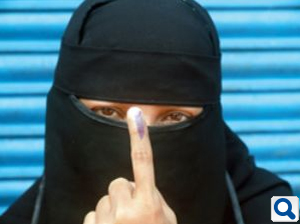NEW DELHI: These are figures the Left Frontshould be wary of as it prepares to defend its citadel of 34 years in West Bengal.
An analysis of data on the Muslim community released by the chief economist of the National Council of Applied Economic Research, Abu Saleh Sheriff, reveals that the state's minority has benefited little from development measures. In terms of human development indices, the Muslims have fared very poorly.
Of the 25.2% Muslim population, only 2.1% have government jobs and 50% children are out of school at the primary level. Only 12% go on to complete matriculation. These numbers are all the more astonishing given the fact that Left swears by its secular credentials and positions itself as a protector of minority rights.
Alarm bells have already started ringing, especially after a postmortem of the Left's poor showing in the civic elections last year. An important factor which could have resulted in the dismal performance was Muslim disenchantment. In what may be viewed as the party's efforts to make amends, there is a steep 33% hike in the number of Muslim candidates fielded by Left Front. It has gone up from 42 in 2006 to 56 this time in the 292-member Assembly.
Throughout his lecture, Sheriff — who has also been the member secretary of the Sachar panel — spoke of Gujarat and West Bengal in the same breath. In fact, he used the data to project the Left-ruled state in a far worse light than the state ruled by Narendra Modi, not regarded by many as a benefactor of the minorities. And this comparison appeared all the more relevant because the West Bengal government had gone out of its way to provide shelter to Qutubuddin Ansari, the man who became the face of the post-Godhra riots with his folded hands and tearful eyes.
"If a substantial fraction of the state's 25% Muslim population have traditionally voted for the alliance it could be because of the projected gains of the land reforms even though if you look at the figures, it shows that these reforms do not seem to have made any significant difference to the living standards of the community. With the elections coming, it is time this reality is brought to the knowledge of the public," Sheriff said. He was addressing a seminar on "Relative development of West Bengal and Socio-Religious Differentials" organized by the Institute of Objective Studies at theIndia Islamic Cultural Cultural Centre.
Shariff's figures on education, sourced, according to him from the census database and the Planning Commission, show 50% Muslim children attend school at the primary level, 26% remain in middle school and only 12% complete matriculation against 54%, 30% and 13% respectively for SC/STs and 80%, 58% and 38% for others.
Of the 90 minority-concentrated districts in the country, West Bengal has 12. "The worst are the state government employment figures where even Gujarat with its 9.1% Muslim population and with a 5.4% share in jobs is way ahead of West Bengal which is by far the worst in the country. We had to try very hard to get these figures out from the state government because, for obvious reasons, they are very secretive about this," Shariff said.


No comments:
Post a Comment